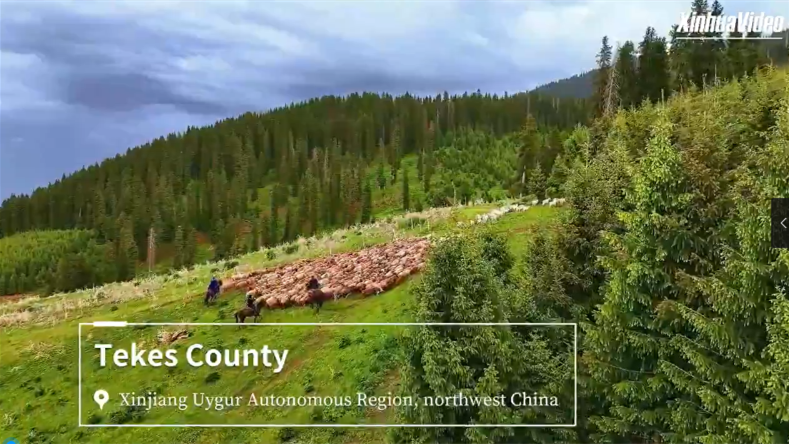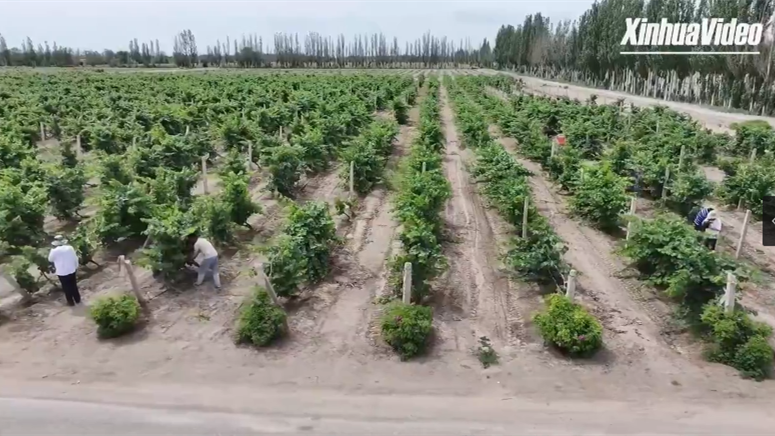Construction and maintenance of roads vital to region's trade and development
At the southern side of Beijing's Tian'anmen Square, visitors can easily find a "zero-kilometer" sign. This marks the starting point of China's extensive highway network that reaches various destinations.
One such destination is in Lhasa, the capital city of the Xizang autonomous region. The destination is marked by a sign that is more conspicuous than the one in Beijing.
The sign is a 20-meter-tall stone stele with inscriptions reading "Sichuan-Xizang and Qinghai-Xizang Highways Monument". It was dedicated to the memory of the workers — mostly soldiers — who devoted their lives to the construction of the two historic roads into Xizang.
In December 1954, the two highways were put into service, ending Tibet's reliance on men, horses and camels to transport goods.
The opening of the highways has played a crucial role in the development of Xizang.
Before the operation of the two roads, trade and travel between Xizang and the rest of the country were made possible through the ancient Tea-Horse Road and Tang-Tibet Road that links Sichuan and Qinghai provinces respectively.
For hundreds of years, cargoes were carried by camels and horses on the two roads and a single trip usually took several months. The low efficiency of transport severely hindered the development of Xizang.
The historic change happened in the early 1950s, with the construction of the Sichuan-Xizang and Qinghai-Xizang highways.
The Sichuan-Xizang Highway is a high-elevation road starting from Chengdu, Sichuan province, in the east and ending at Lhasa, in the west. The highway has two routes — the south line with a length of 2,115 kilometers and the north line which spans 2,414 km.
Construction of the highway started in April 1950, when the road builders cleaved mountains and crossed waters, and it was finally opened for traffic on Dec 25, 1954.
Starting from Xining, capital of Qinghai province, the Qinghai-Xizang Highway stretches 1,947 km into Xizang with an average elevation of above 4,000 meters. Winding along the Kunlun Mountains, Tangula Mountains, Tuotuo River and vast grasslands, it began construction on May 11, 1954, and was also opened to traffic on Dec 25, 1954.
Due to the harsh natural environment along the roads, the two projects were called by many "a miracle of road construction in the world". More than 3,000 people died during their construction.
After the construction was completed, the maintenance of the two roads was also called another miraculous achievement of the world because of the extremely challenging natural environment.
According to Ma Guodong, a civil engineering expert at the Ministry of Transport, what made the miraculous achievements possible are the "Two Roads Spirits" that feature great courage, long-term dedication and the unity of people of various ethnicities, during the construction and maintenance of the roads.
"The Two Roads Spirits have thrived for decades, and will continued to be cherished by the people in Xizang and other regions along the roads, as a source of inspiration to drive further progress," Ma said.
The spirits have also been inscribed on the Sichuan-Xizang and Qinghai-Xizang Highways Monument. While giving a brief retrospective of the history of the roads' construction, the inscriptions state that the great spirits of road builders and workers should be remembered forever.
Civil engineering miracle
When the 18th Army of the People's Liberation Army was ready to enter Xizang for a peaceful liberation of the region in early 1950, they were required by the Central Committee of the Communist Party of China to build a modern highway for the better socioeconomic development of Xizang.
Construction of the Sichuan-Xizang Highway began in April 1950. At an oath-taking rally held in March, Zhang Guohua, commander of the army, called on the soldiers to renew their courage to tackle all the challenges for a new mission that was even tougher than the battles they had faced.
The construction of the highway needed to cross dozens of snow-covered mountains and torrential rivers. Thus route planning was crucial for the project.
Survey and route planning were carried out section by section, just slightly ahead of the construction process due to a tight schedule. Yu Jiong, a senior civil engineer from Sichuan, was tasked with heading a team for route survey and planning.
Their mission spanned one year and three months, traveling more than 4,000 km through the high mountains and across deep rivers. They proposed seven routes for comparison and offered suggestions for the decision-makers to choose the best one.
With high elevation and harsh geographical conditions, the building of the Sichuan-Xizang Highway was an unprecedented challenge to highway construction.
Wang Changwei is the daughter of Wang Qimei, then deputy political commissar of the army. She recalled what her father told her about the difficulties in roadbuilding.
"When construction took place in high-altitude areas in the winter, extreme coldness was the biggest challenge that the soldiers had to overcome," she cited from what her father told her. "Sometimes their hands would be stuck to the steel chisels when they were drilling blast holes on the cliffs."
Landslides, collapse of mountain slopes, falling rocks and high-altitude sickness happened frequently, which could easily take the lives of the soldiers and workers. Each kilometer of the highway was built at the cost of the life of one builder.
Strategic vision
Construction of the Qinghai-Xizang Highway began on May 11, 1954. When talking about this project, Mu Shengzhong is the most frequently mentioned name.
In early 1950, Mu was appointed as the political commissar of the Independent Division of the 18th Army, which was ordered by the CPC Central Committee to enter Xizang via Qinghai. This was a route roughly in line with the ancient Tang-Tibet Road, along which, famed early Tang Dynasty (618-907) Princess Wencheng traveled to Xizang for a historic marriage with Tibetan King Songtsen Gampo.
The Independent Division began its journey from Lanzhou, capital city of Northwest China's Gansu province, on July 11, 1950 and arrived in Lhasa in December that year.
In the following two years, Mu headed the mission of transporting supplies to Xizang several times. Every time he traveled, he would pay attention to and record the topographic features and weather conditions of the routes and produce a research report later.
The trips spurred Mu to propose the building of another highway to link Qinghai and Xizang, which was not in the central authorities' plan originally.
Mu was not a civil engineer by profession. But he had a strong willingness to learn, to research, to think and to act. And he had a strategic vision to guide his actions.
On another mission to Beijing in May 1953 to receive supplies, he chose to travel through the Tea-Horse route, where the construction of the Sichuan-Xizang Highway was going on. The trip was aimed at comparing this southern route and the Qinghai-Xizang route that he had studied for a long time.
Mu found that the Sichuan-Xizang Highway would have its limits even after its operation — natural conditions like snow, fog, flooding and landslides would be frequent challenges that could not be easily overcome by human efforts. In comparison, a Qinghai-Xizang highway could be easier to build and maintain because of the flat terrain and dry weather, despite the higher altitude.
During that time in Beijing, he put forward a formal proposal for building the Qinghai-Xizang Highway — with research reports attached — to the central authorities. To his delight, the proposal was quickly approved.
On May 11, 1954, Mu headed thousands of construction workers and engineers to began the highway's construction from Qinghai's Golmud.
Thanks to the scientific planning and the workers' morale of "fearing neither hardship nor death", the road's construction proceeded at an astonishing efficiency. It was opened to traffic on Dec 25, 1954.
During the process of construction, Mu was more like a soldier charging on the frontlines instead of an officer commanding in the rear. He took part in heavy manual work alongside the ordinary workers.
The general was fully aware of the danger of laboring in high-altitude areas, which could easily take one's life. "If I die in building the road, just bury me on the site," he said. "If I die afterward, just throw my ashes along the road."
He fulfilled his promise. After he died in 1994, his ashes were thrown along the road.
Long-term devotion
With the two highways in place, their maintenance posed a great challenge. However, the challenge has been tackled over the years because of the long-term devotion of road maintenance workers.
Both on the Qinghai-Xizang or Sichuan-Xizang lines, to keep the traffic open and smooth in adverse natural conditions like blizzards, floods, landslides and the thawing of frozen soil is not an easy job for road maintenance workers. But they succeeded as a result of painstaking efforts.
On the Qinghai-Xizang Highway, the famed Road Maintenance Station 109 is called the "No 1 road maintenance station under the heaven" because it is located at the Tangula Pass with an altitude of more than 5,200 meters — the highest point of the road.
At the border of Xizang and Qinghai, this is an important facility ensuring the safe operations of the highway, seeing an annual traffic volume of more than 1.3 million vehicles, according to the latest statistics of the Qinghai-Xizang Highway Management Bureau.
For the maintenance workers there, it can be a tough life. In addition to the extremely high altitude and isolation from the rest of the world, blizzards that are frequent on the Qinghai-Tibet Plateau from October to April, are a major threat to the lives of workers and the operation of the road. Despite the difficulties, workers there have seen keeping the highway running smoothly as a lifelong mission.
Bacha, 76, was the former chief of the station. He worked there for decades since being employed there in 1962.
Bacha said his career was inspired by the previous generation of road maintenance workers, who showed him the precious values of benevolence, unity, sense of responsibility and long-term devotion.
He said that his first acquaintance with the workers was some day in 1961. That period saw a severe natural disaster throughout the country and an inadequate food supply was a challenge facing many people.
Bacha once lingered around this station in his neighborhood, in the hope of finding something to eat.
He said the chief of the station at that time, who was surnamed Zhang, gave him a piece of steamed bun, which was the last portion of his daily food supply. In the following days, other workers there did the same for him.
In his gratitude, Bacha visited the station frequently, trying to help with cooking and washing. He was also employed by the station when he reached working age in 1962. Since then, he worked there for more than 30 years.
Among the many critical moments in the history of the highway's maintenance, Bacha said the most unforgettable one was a big blizzard in October 1985, which had covered nine counties in Xizang's Nagchu prefecture.
When disaster victims were badly in need of supplies for relief, the rescue fleets were stranded at the snow-blocked Tangula Pass.
"Under the temperature of — 40 C, we worked day and night, shoving the snow off the road, and finally cleared the way for vehicles," Bacha said.
The heavy workload in extreme weather and high altitude caused many health problems for workers, with frostbite as the slightest and severe pneumonia as the most severe.
However, Bacha and his colleagues felt relieved when there was no single casualty case reported in disaster-hit regions.
Progress going on
Inspired by the Two Roads Spirits created by the road builders and maintenance workers, the people of Xizang have been devoting more energy to driving the development of the local transport industry and have made more achievements.
The two highways have developed into the key economic arteries of Xizang, shouldering more than 90 percent of the freight transportation volume entering and exiting the region, Dawa Ngodrub, deputy head of Xizang's transportation department, said at a recent news conference.
Based on the success of the two highways, the transport network in Xizang has increased steadily.
The Xinjiang-Xizang Highway and the Yunnan-Xizang Highway became operational in 1957 and 1976 respectively, forming an outbound highway network reaching all of Xizang's neighboring regions within the territory of China. Inside Xizang, a highway linking Metog county in Nyingchi city was opened to traffic in 2013, breaking the blockage to China's last county without road access.
The total distance of roads opened in Xizang has reached 123,300 km. As of the end of 2023, 93,000 km of the roads were in rural areas. Townships and administrative villages are now 100 percent accessible.
The Qinghai-Xizang Railway became operational in 2006. The operation of the Lhasa-Nyingchi Railway began in 2020.
Travel to, from and inside Xizang is now more convenient with the development of comprehensive transport networks of highways, railways and civil aviation.


.png)

.png)

.png)























